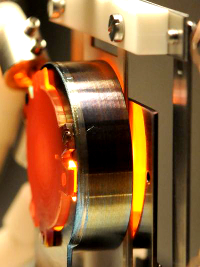Tests to enflame thermo-power revolution
 Engineers have been working for decades on the best way to harness the power of thermionic conversion, hoping to develop an efficient way to draw electricity from any source of heat.
Engineers have been working for decades on the best way to harness the power of thermionic conversion, hoping to develop an efficient way to draw electricity from any source of heat.
A new design by a group of German researchers has been dubbed the ‘thermoelectronic generator’, an optimistic title that could well be justified in an upcoming energy revolution.
The design described in the Journal of Renewable and Sustainable Energy (JRSE) uses the temperature difference between a hot and a cold metallic plate to create electricity.
“Electrons are evaporated or kicked-out by light from the hot plate, then driven to the cold plate, where they condense,” explained experimental solid-state physicist Jochen Mannhart, from the Max Planck Institute for Solid State Research in Stuttgart and lead author of the JRSE paper.
The difference in charge between the two plates yields a voltage which in turn drives an electric current, “without moving mechanical parts,” Mannhart noted.
There is still a way to go before a truly usable device is developed, but the researchers say impetus now lies with industrial backers.
“Practical thermionic generators have reached efficiencies of about 10 percent. The theoretical predictions for our thermoelectronic generators reach about 40 percent, although this is theory only,” Mannhart said.
“We would be much surprised if there was a commercial application in the marketplace within the next five years, but if companies that are hungry for power recognize the potential of the generators, the development might be faster.”







 Print
Print